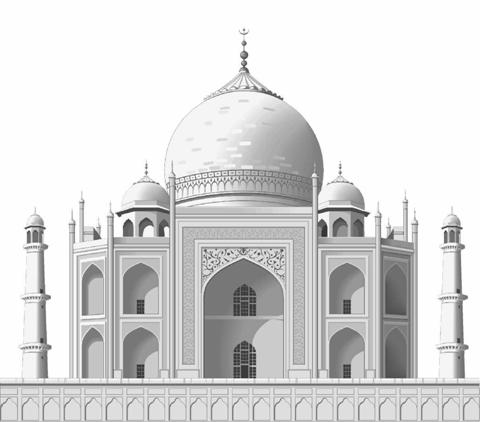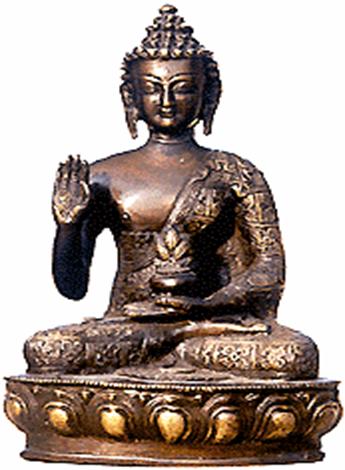The old Indian civilization
Страница 4
The Hindus followed the rigid caste system while the Muslims believed in the equality of all men before their god, Allah.
Although Muslim control of northern India ended at the close of the fourteenth century, the hostilities between Hindus and Muslims in Indian society have continued to the present.
Muslims contributed to the development of Indian culture. They left the valuable monument of art, the great masterpiece – Taj Mahal.
Taj Mahal
 Of the seven Wonders of the Ancient World, two were dedicated to sentiment in marriage: the Mausoleum, monument of a wife’s devotion to the memory of her husband; the Hanging Gardens of Babylon, erected by a husband for the happiness of a favourite wife. Among the wonders of the modern world, one of the most famous commemorates a husband’s devotion to a wife.
Of the seven Wonders of the Ancient World, two were dedicated to sentiment in marriage: the Mausoleum, monument of a wife’s devotion to the memory of her husband; the Hanging Gardens of Babylon, erected by a husband for the happiness of a favourite wife. Among the wonders of the modern world, one of the most famous commemorates a husband’s devotion to a wife.
It is, of course, the incomparable Taj Mahal, the tomb that Shah Jehan created for the beauteous Mumtaz Mahal, at the city of Agra, in India. The French traveler Francois Bernier, who toured the East three centuries ago, was in Agra during the 1660s, saw the building when it had been up for less than twenty years, and wrote in his journal: “Possibly I have acquired an Indian taste, but I am of the opinion that this monument has much more right to be included among the wonders of the world than the pyramids of Egypt”. Some critics have gone beyond him, declaring the Taj Mahal to be the most beautiful edifice ever erected by man. Shah Jehan was one of the Mogul emperors who reigned over India in golden splendour. A Moslem, he practiced the polygamy ordained in the Koran, which permitted four wife not counting the concubines whom it was customary for an Islamic potentate to have in his harem. Mumtaz Mahal, young dainty, and beautiful, was the favourite wife. Taj Mahal, therefore, is a monument to romantic sentiment in the harem, a husband’s devotion in polygamous family life.
The Taj Mahal is the masterpieces of Mohammedan Art. That it arose on Indian soil is explained by history. The Moglus came originally from Central Asia, their name being a variant of the world “Mongol”. They were Moslems, and they conquered India.
The founder of the Mogul Empire was one of the remarkable men of all time. In martial ardor and ability to command, Baber may have been a typical princeling of Iartary, but he was also a man of culture, the author of perhaps best political memoirs ever written by a reigning monarch. In December of 1525 he led his army into India. The battle took place on April 12, 1526, and proved to be one of the decisive conflicts of world history for Baber won the victory, that gave him a permanent foothold in the land that was to be ruled by this descendants.
Baber did not finish the work of integrating an imperial domain. But the Moguls were lucky in the next representative of their dynasty Akbar, known to history as Akbar The Great. He introduced a new system of government, bringing ale the land under his direct authority naming his own viceroys, setting up a comprehensive tax levy, keeping the provincial military forces in the pay of the central treasury to prevent local rebellious before they could get started.
At his death (1605) he left behind an empire so closely knit and organized that it could continue in much the same form for another century. By patronizing artists and architects he forwarded the development of style and skill to the point where under his grand son, the miracle of the Taj Mahal became possible. Akbar was succeeded by his son Sahangir, the potentate to whom the title of “The Great Mogul” was first applied. The imagination of the west was inflamed, by stories of the beauty, power, luxury and oriental splendour of the Mogul Empire. Merchants, travellers, ambassadors, missionaries – all helped to fill in the picture of the Great Mogul and his kingdom.
Iahangir died in 1627 and the throne passed to his son, Shah Jehan. Under his popular rule the Mogul Empire reached its height. His reign was remembered for its order, security and justice. In 1612 he had married Argumand Banu a cousin, and their wedded bliss until her death in 1631 constitutes one of the great love stories of the world. It was not dimmed by the fact that Shah Jehan, in Moslem fashion, had a harem of other wives. She was his favourite, the one he called Mumtaz Mahal, or Ornament of the Palace”. A powerful influence with him, she was largely responsible for his orthodox Mohammedanism, for she held strictly to the tenets of Islam Mumtaz Mahal bore her husband fourteen children, the last of which caused her death on June 17, 1631.
Shah Ielah reacted to the tragedy as did Artemisia on the death Mausolus. He was so inconsolable that it was feared he would die of grief. In fact he never recovered from the shock, although he did rouse himself because he wanted to venerate the memory of his wife, with a suitable monument. The greatest thing he did during the rest of his reign was to build the Taj Mahal. As a site he chose a high bank of the Yumna River, one of the holy rives of Hundustan, where it bends around at Agra. He summoned the finest architects and craftsmen from all over his empire and had them submit plans for the proposed buildings. The Portuquese Iesuists in Agra reported that the man who won was a Venetian Geronimo Verroneo, and that this Westerner actually erected the Taj. But that story has been rejected by some later scholars on the grounds that the building shows no European influence. Other accounts name a Turk or a Persian.
The basic material used was wite marble, with the wall and gates of red sandstone, a colour scheme, that has the remarkable effect of showing different tints at different times of the day. The building stands on a 186-foot square with the angles cut to form on octagon. Beneath it is a raised marble platform, extending all around and marked by delicate minarets at each corner. Above swells the great dome, about two thirds of a sphere, surmounted by a crescent and flanked by smaller domes, each of the walls is cut by arches of a similar but not at all mono fonous pattern, rather, they contribute to the unity of the whole, Light enters through marble screens.
There is an old saying that “The Moguls built like titans and finished like jewelers”. The Taj Mahal proves the truth of the remark. Looked from a distance, its appearance is indeed dreamlike, with a grare and balance that make us wonder how human beings ever achieved so miraculous a result from marble and sandstone.
After Shah Jehan the Mogul Empire had no place to go except downward. This great ruler lived to see the first bitter fruits of failure, for his sons rebelled against him, and the one who came out on top, Aurangzeb, deposed him and threw him into prison.
Then Aurangzeb moved the capital of the Mogul Empire from Agra to Delhi. For seven years Shah Jehan remained in a cell in the fort at Agra, protesting against the unfilial behaviour of the new emperor, and spending much of his time gazing across at the Taj Mahal where the symbol of his best days lay Buried. Shah Iahan died in 1658 and finally left prison to lie by the side of Mumtaz Mahal in her glorious tomb. Aurangzeb maintained his throne for fifty years, the last Mogul of any consequence. On his death in 1767 fierce fighting among his sons broke out. Final ruin came in 1739 when the powerful king of Persia, Nadir Shah, invaded Hundustan. From then on the Mogul Empire of Akbar, Yahangir, and Shah Jehan, was but a memory, but it had left behind a colorful page of history climaxed by the enduring monument that attracts and charms visitors to this day that wonder the modern world, the Taj Mahal.
But India is famous not only for this monument of art – It has other wonderful masterpieces of architecture.
Art of India
 Indian civilization was one of the oldest and most original in the East. Her contribution to world culture was great. In the ancient times, India was famed for her wonderful miracles, vast natural resources and craft works.
Indian civilization was one of the oldest and most original in the East. Her contribution to world culture was great. In the ancient times, India was famed for her wonderful miracles, vast natural resources and craft works.